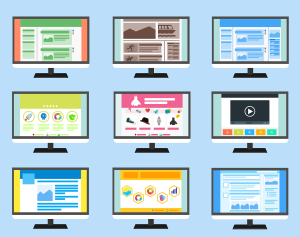
Visual storytelling is no longer just a buzzword; it’s a vital component of modern web design that shapes how brands connect with their audience. In today’s fast-paced digital environment, users seek quick, engaging content, and visual storytelling meets this demand perfectly. The widespread use of images and short videos has shown how effective these mediums can be in capturing attention and driving engagement. But what exactly is visual storytelling? It’s the practice of conveying a narrative primarily through visual media, such as images, videos, and infographics, to create a cohesive and compelling story that resonates with the audience. In web design, this involves using visuals not just as decoration but as integral elements that enhance the user experience and communicate the brand’s message without relying heavily on text. This approach leverages the brain’s natural preference for processing images over words, making it a highly effective tool for engaging users. Studies have shown that the human brain can process entire images in just milliseconds, highlighting the importance of visuals in quickly conveying complex ideas.
The Impact of Visual Storytelling on User Experience
User experience (UX) is at the heart of web design, and visual storytelling plays a crucial role in enhancing it. By using visual elements strategically, designers can create a more intuitive and enjoyable experience for users. For example, the use of a visual narrative on a landing page can help guide the user’s eye to key information, reducing cognitive load and making the content more digestible. Tools like Figma and Adobe XD have become indispensable for designers looking to integrate visual storytelling into their projects. These platforms offer robust features for creating interactive prototypes that allow designers to experiment with different visual elements and layouts to see what works best for their audience. A good visual story can also evoke emotions, which can significantly impact user behavior. Emotional responses often lead to higher engagement rates and can drive users to take action, whether it’s making a purchase, signing up for a newsletter, or sharing content on social media. In fact, according to a report by the Nielsen Norman Group, emotionally engaging content can increase the likelihood of a user remembering a brand by up to 23% (Nielsen Norman Group).
Current Trends in Visual Storytelling for Web Design
The landscape of web design is constantly evolving, and so are the trends in visual storytelling. One of the most significant trends is the use of immersive storytelling techniques, such as parallax scrolling and 3D visuals. These techniques create a sense of depth and interaction, making the user feel more connected to the content. Another trend is the use of micro-interactions, which are subtle animations or design elements that respond to user actions. These can include hover effects, scrolling animations, or clickable elements that provide immediate feedback to the user. Micro-interactions are a powerful way to enhance visual storytelling by making the user experience more engaging and interactive. They help create a sense of connection between the user and the content, making the website feel more dynamic and responsive. For instance, when a user hovers over a button and it changes color or shape, this small interaction can make the user feel more involved in the experience, encouraging them to continue exploring the site.
Another prominent trend is the incorporation of video backgrounds and cinemagraphs. These elements add a layer of motion to a webpage, bringing stories to life in a way that static images cannot. Video backgrounds, when used appropriately, can instantly grab attention and convey a story within seconds. Cinemagraphs, which are essentially still images with subtle, looping motion, offer a more understated way to incorporate movement without overwhelming the viewer. Tools like Lottie and After Effects are popular among designers for creating these types of animations, allowing for intricate, lightweight animations that load quickly on the web.
The use of bold typography as a visual storytelling tool has also gained traction. Typography can go beyond mere readability; it can set the tone, create emphasis, and even act as a visual element in its own right. Designers are increasingly experimenting with custom fonts, oversized text, and creative layouts to add personality and drama to their designs. This trend is particularly effective when combined with minimalist design principles, where typography becomes the hero of the page, delivering the message in a clean, impactful way.
How Visual Storytelling Drives Conversions
Visual storytelling is not just about creating a pretty website; it’s a strategic approach that can significantly drive conversions. By guiding users through a visual narrative, designers can lead them to key conversion points in a natural and persuasive manner. For example, a well-crafted hero image at the top of a webpage can instantly communicate the value proposition, drawing users in and encouraging them to scroll down to learn more. As users move through the site, strategically placed visuals and calls to action (CTAs) can steer them toward making a purchase or signing up for a service.
Data supports the effectiveness of visual storytelling in driving conversions. According to a study by MDG Advertising, content featuring compelling images can generate 94% more views than content without visuals. Moreover, eye-tracking studies have shown that users spend more time looking at images than reading text, especially when the images are relevant to the content. This highlights the importance of selecting visuals that are not only aesthetically pleasing but also closely aligned with the brand’s message and goals. Successful brands, such as Apple and Airbnb, have consistently leveraged visual storytelling to create immersive, memorable experiences that drive user engagement and conversions (Smashing Magazine).
Examples of Brands Successfully Using Visual Storytelling
Some of the most successful brands have mastered the art of visual storytelling to drive engagement and conversions. Apple, for example, uses minimalist design combined with high-quality visuals to tell the story of innovation and premium quality across its website. The seamless integration of product images, videos, and interactive elements guides users through a narrative that emphasizes the brand’s cutting-edge technology and design ethos.
Another great example is Airbnb, which uses a mix of user-generated content, professional photography, and video to create a compelling narrative around travel and unique experiences. The website’s design allows users to visualize themselves in various destinations, making the browsing experience highly immersive and aspirational. By showcasing real-life stories and authentic visuals, Airbnb successfully builds trust and emotional connections with its audience, which translates into higher booking rates.

For smaller brands looking to leverage visual storytelling, tools like Canva and Visme offer accessible ways to create professional-grade visuals without the need for extensive design skills. These platforms provide templates, design elements, and drag-and-drop functionality that make it easy to produce engaging visuals that can be integrated into any website design.
Key Elements of Effective Visual Storytelling
When it comes to creating a compelling visual story on your website, certain elements are crucial for ensuring the message is clear, engaging, and memorable. These components work together to form a cohesive narrative that can captivate your audience and drive the desired actions.
- Consistency: Maintaining a consistent visual style across your website is essential. This includes using a uniform color palette, typography, and design elements that align with your brand identity. Consistency helps reinforce your brand message and makes your website more visually appealing.
- Clarity: Your visuals should clearly communicate your message without overwhelming the viewer. Use imagery that directly relates to your content and supports your narrative. Avoid clutter and ensure that each visual element serves a purpose in your storytelling.
- Emotion: Emotional engagement is a powerful driver of user behavior. Incorporate visuals that evoke specific emotions, whether it’s excitement, nostalgia, or empathy. This can make your content more relatable and encourage users to connect with your brand on a deeper level.
- Authenticity: In today’s market, consumers value authenticity. Use real, relatable visuals rather than overly polished stock images. User-generated content, behind-the-scenes photos, and genuine customer stories can add authenticity to your visual storytelling, making your brand more trustworthy.
- Interactivity: Incorporating interactive elements into your visual storytelling can greatly enhance user engagement. This can include clickable images, hover effects, or even gamified content. Interactive visuals invite users to participate in the story, making the experience more immersive and memorable.
These key elements, when combined effectively, can transform your website into a powerful storytelling platform that not only informs but also engages and converts your audience.